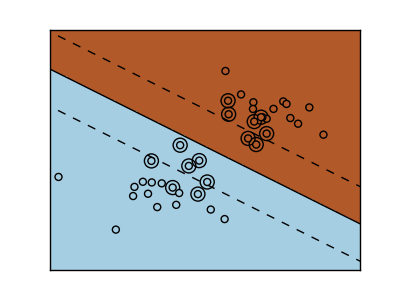SVM Margins Example¶
The plots below illustrate the effect the parameter C has on the seperation line. A large value of C basically tells our model that we do not have that much faith in our data’s distrubution, and will only consider points close to line of seperation.
A small value of C includes more/all the observations, allowing the margins to be calculated using all the data in the area.
Python source code: plot_svm_margin.py
print __doc__
# Code source: Gael Varoqueux
# Modified for Documentation merge by Jaques Grobler
# License: BSD
import numpy as np
import pylab as pl
from sklearn import svm
# we create 40 separable points
np.random.seed(0)
X = np.r_[np.random.randn(20, 2) - [2,2], np.random.randn(20, 2) + [2, 2]]
Y = [0]*20 + [1]*20
# figure number
fignum = 1
# fit the model
for name, penality in (('unreg', 1), ('reg', 0.05)):
clf = svm.SVC(kernel='linear', C=penality)
clf.fit(X, Y)
# get the separating hyperplane
w = clf.coef_[0]
a = -w[0]/w[1]
xx = np.linspace(-5, 5)
yy = a*xx - (clf.intercept_[0])/w[1]
# plot the parallels to the separating hyperplane that pass through the
# support vectors
margin = 1/np.sqrt(np.sum(clf.coef_**2))
yy_down = yy + a*margin
yy_up = yy - a*margin
# plot the line, the points, and the nearest vectors to the plane
pl.figure(fignum, figsize=(4, 3))
pl.clf()
pl.set_cmap(pl.cm.Paired)
pl.plot(xx, yy, 'k-')
pl.plot(xx, yy_down, 'k--')
pl.plot(xx, yy_up, 'k--')
pl.scatter(clf.support_vectors_[:, 0], clf.support_vectors_[:, 1],
s=80, facecolors='none', zorder=10)
pl.scatter(X[:,0], X[:,1], c=Y, zorder=10)
pl.axis('tight')
x_min = -4.8
x_max = 4.2
y_min = -6
y_max = 6
XX, YY = np.mgrid[x_min:x_max:200j, y_min:y_max:200j]
Z = clf.predict(np.c_[XX.ravel(), YY.ravel()])
# Put the result into a color plot
Z = Z.reshape(XX.shape)
pl.figure(fignum, figsize=(4, 3))
pl.set_cmap(pl.cm.Paired)
pl.pcolormesh(XX, YY, Z)
pl.xlim(x_min, x_max)
pl.ylim(y_min, y_max)
pl.xticks(())
pl.yticks(())
fignum = fignum + 1
pl.show()


